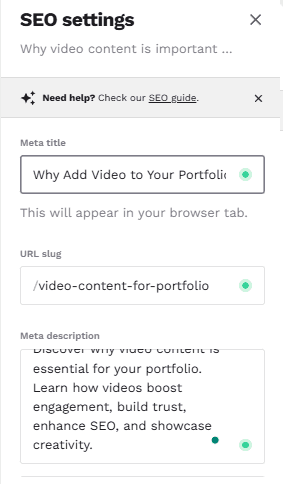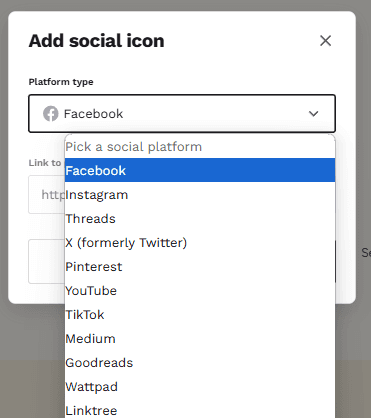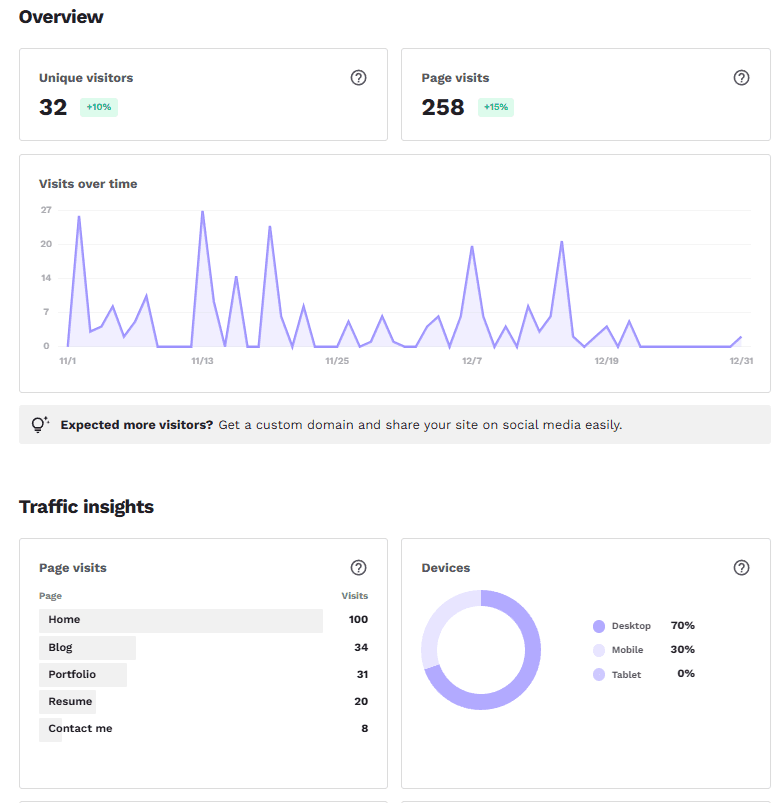How to Write Meta Descriptions and Optimize Your Copyfolio Portfolio for SEO
In today’s digital landscape, having a strong online presence is crucial, especially for creative professionals like writers, designers, and marketers. Your portfolio is your digital storefront, and optimizing it for search engines (SEO) can help you stand out in a competitive market.
One of the most important yet often overlooked aspects of SEO is the meta description. In this blog, we’ll explore how to write compelling meta descriptions and optimize your Copyfolio portfolio for better visibility on search engines.
What is a Meta Description?
A meta description is a short snippet of text (typically 150–160 characters) that summarizes the content of a webpage. It appears below the page title in search engine results pages (SERPs) and plays a crucial role in enticing users to click through to your site. While it doesn’t directly impact rankings, a well-crafted meta description can improve your click-through rate (CTR), which indirectly boosts SEO.
How to write an effective Meta description
Keep it concise and relevant
Stick to the 150–160 character limit to ensure your description isn’t cut off in search results. Make sure it accurately reflects the content of the page.Include target keywords
Incorporate relevant keywords naturally into your meta description. This helps search engines understand the page’s content and improves visibility for those terms.Write for humans, not just search engines
While keywords are important, your meta description should also appeal to users. Use action-oriented language and highlight the value of your page.Add a Call-to-Action (CTA)
Encourage users to take action by including a CTA like “View my portfolio,” “Explore my work,” or “Contact me today.”Make It Unique
Avoid duplicate meta descriptions across your pages. Each page should have a tailored description that reflects its specific content.Example:
“Explore my professional writing portfolio showcasing SEO-optimized blog posts, website copy, and marketing content. Let’s collaborate on your next project!”
How to Optimize Your Copyfolio Portfolio for SEO
Copyfolio is a popular platform for creating stunning portfolios, but without proper SEO optimization, your work might not get the visibility it deserves. Here’s how to make your Copyfolio portfolio SEO-friendly:
1. Choose the right keywords
Research keywords that potential clients or employers might use to find someone with your skills. For example:
“Freelance writer portfolio”
“Graphic designer for hire”
“SEO copywriter portfolio”
Use these keywords strategically in your portfolio’s title, headings, and descriptions. You can use Google ads keyword planner to find out relevant keywords.
2. Craft a Compelling Headline
Your portfolio’s headline is the first thing visitors see. Make it clear, concise, and keyword-rich. For example:
“Award-Winning Graphic Designer | Specializing in Branding and Web Design”
“Professional Copywriter | Crafting Engaging Content for Brands”
3. Write detailed project descriptions
For each project in your portfolio, include a detailed description that highlights your role, the tools you used, and the results you achieved. Use keywords naturally and provide context to showcase your expertise.
Example:
“Designed a responsive website for a local bakery, increasing their online orders by 40%. Tools used: Figma, WordPress, and Adobe Creative Suite.”
Here’s a breakdown of the options available:
Meta title:
This option lets you set the title of your portfolio page, which appears in the browser tab and as the main headline in search engine results. A well-crafted title should be clear, engaging, and include primary keywords (e.g., "Video Content Portfolio | Showcase Your Work and Boost Engagement").URL:
This field allows you to customize the URL of your portfolio page. A clean, descriptive, and keyword-rich URL improves SEO and makes it easier for users to understand the page's content (e.g., "yourportfolio.com/video-content-portfolio").Meta Description:
This field allows you to write a concise and compelling summary of your portfolio page. The meta description appears below the page title in search engine results and should include relevant keywords to attract clicks. For example, you can highlight how video content enhances engagement, builds trust, and improves SEO.
4. Optimize Images and Media
Use descriptive file names for your images (e.g., “freelance-graphic-designer-portfolio.jpg”).
Add alt text to all images to improve accessibility and SEO.
Compress images to ensure fast loading times, which is a ranking factor.
5. Leverage Custom URLs
Copyfolio allows you to customize your portfolio’s URL to include your name or primary keyword. For example:
6. Add a Blog or case studies section
Including a blog or case studies on your portfolio can boost your SEO by providing fresh, relevant content. Share insights about your creative process, industry trends, or behind-the-scenes looks at your projects.
7. Include client testimonials
Testimonials add credibility to your portfolio and can include keywords naturally. For example:
“John’s SEO-optimized blog posts helped us increase organic traffic by 50% in just three months.”
8. Link to your social profiles and website
Add links to your LinkedIn, Behance, or personal website to build authority and improve your online presence.
You can easily add social icons with Copyfolio.
9. Enable Analytics
Copyfolio has integrated analytics so you don't have to worry about implementing other tools right from the start. You can see all of your insights through your profile.
10. Promote Your Portfolio
Share your portfolio on social media, forums, and professional networks like LinkedIn. The more backlinks and traffic your portfolio generates, the better it will rank on search engines.
Final thoughts
Optimizing your Copyfolio portfolio for SEO doesn’t have to be complicated. By writing compelling meta descriptions, using relevant keywords, and showcasing your work effectively, you can attract more visitors and potential clients.
Remember, SEO is an ongoing process, so regularly update your portfolio with new projects and content to stay ahead of the competition.
Your portfolio is a reflection of your skills and creativity—make sure it’s discoverable by the right audience. Start optimizing today and watch your online presence grow!
Pro Tip: If you’re new to SEO, consider using tools like Google Keyword Planner, Yoast SEO, or SEMrush to streamline your optimization efforts. Happy optimizing! 🚀
You can use my Copyfolio discount code FRANKOVIC20 for 20% off on your monthly or annual subscription.
Looking for a great deal on your Copyfolio subscription? Use the exclusive Copyfolio discount code FRANKOVIC20 to enjoy 20% off both monthly and annual subscriptions. Whether you're building a stunning portfolio to showcase your skills or creating a sleek website to impress potential clients, this discount helps you save while you elevate your personal brand.




